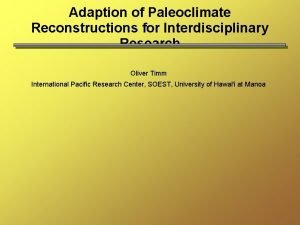Complexities of modern leaf morphology climate proxies and

- Slides: 1

Complexities of modern leaf morphology, climate proxies, and applicability in the fossil record Claire 1, 2 Cleveland , 1 Hargrave , 2 Bancroft , Jennifer Betsy R. Matthew 1 2 Departments of Physical Science and Biology Collection Introduction 2 Ogburn Undergraduate Research and Scholarship Program Analysis Ó Leaf traits including roundness, toothiness, and stomatal densities have been used as climate proxies with some success (Mc. Elwain and Chaloner, 1995; Royer et al. , 2005). Discussion Ó However, proxies are often confounded by a range of evolutionary and environmental interactions (Holland Richardson, 2007). Our results support variation in physiological response patterns from current assumptions. However, stronger paleoclimate resolution may be achieved by combining multiple continuous morphological traits to quantify proxy signal strength and signal direction in current proxy applications (Fig. 6). 2459 m 2037 m Ó An understanding of these response patterns in specific conditions may provide valuable constraints on the paleontological record. 1314 m Predictions a Given current proxy assumptions, we expect toothiness, roundness, and stomatal densities to increase with elevation. Royer D. , P. Wilf, D. Janesko, E. Kowalski, and D. Dilcher. 2005. Correlations of climate and plant ecology to leaf size and shape: potential proxies for the fossil record. American Journal of Botany 92: 1141 -1151. Mc. Elwain, J. and W. Chaloner. 1995. Stomatal density and index of fossil plants track atmospheric carbon dioxide in the Paleozoic. Annals of Botany 76: 389 -395. Holland N. and A. D. Richardson. 2009. Stomatal length correlates with elevation of growth in four temperate species. Journal of Sustainable Forestry 28: 63 -73. As expected, roundness increases with increasing elevation (Fig. 3). However, toothiness and stomatal density decrease with increasing elevation (Figs. 4 -5). Fig. 6 This toothy and elongate leaf compression (~72 Ma), found in a floodplain locality interspersed with ponds and lakes, indicates a warm climate and moderate to high water availability. Stomatal Density Literature Results Toothiness Betula occidentalis (western water birch) was studied over an 1100 m elevation gradient in southwestern Utah to observe morphological changes in response to changes in elevation. Random leaf samples were collected from 30 B. occidentalis shrub clusters at each elevation site. The samples were then scanned and peeled for analysis (Figs. 1 and 2). Statistical analyses were completed using R 3. 1. 0 (Figs. 4 -5). Fig. 2 Stomatal peels (top). Dimensional analyses was performed using an Image. J plugin, Object. J 1. 03 p (lower left), stomatal counts at 400 x magnification (lower right: a. 8000 m site and b. 4000 m site) Fig. 1 Collection sites range over an 1100 m gradient crossing ecotones as shown (left). Decreasing Roundness Methods b Acknowledgements Elevation (m) Fig. 3 Roundness, long diameter versus round diameter calculated from lamina area, indicates a negative relationship with elevation (ANOVA p=0. 0002). Elevation (m) Fig. 4 Toothiness, defined as absence space versus potential entire space, indicates a negative relationship with elevation (ANOVA p=0. 00004). Elevation (m) Fig. 5 Stomatal density, stomata per cm 2, indicates a negative relationship with elevation (ANOVA p=0. 001). This research has significantly benefitted from the input of Ian Miller, Ph. D. , at the Denver Museum of Nature and Science. Many thanks to Aaron Cleveland Coral Gardner for their assistance in the field and to Jeff Chipman for his GIS assistance. Funding provided by the Undergraduate Research and Scholarship Program (UGRASP) and the Honors Program at Southern Utah University.

